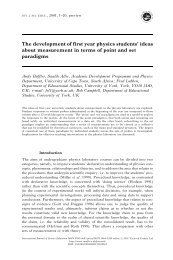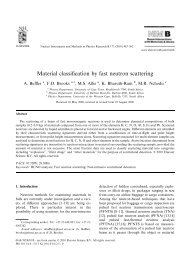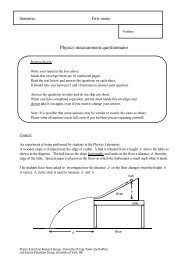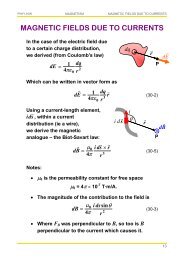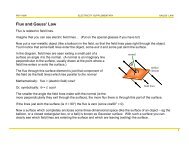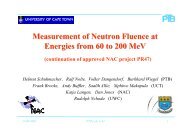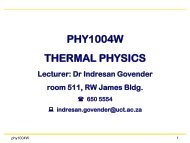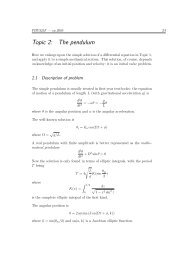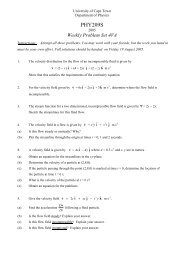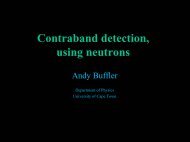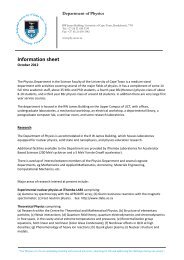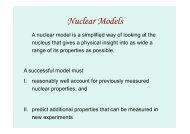(b) (a)
(b) (a)
(b) (a)
You also want an ePaper? Increase the reach of your titles
YUMPU automatically turns print PDFs into web optimized ePapers that Google loves.
Initial shape and final flow fluctuations in<br />
event-by-event hydrodynamics for RHIC and LHC ∗<br />
Ulrich Heinz, The Ohio State University<br />
Exploring QCD Frontiers: From RHIC and LHC to EIC<br />
Stellenbosch, Jan. 30 - Feb. 3, 2012<br />
with Zhi Qiu, Chun Shen & Huichao Song<br />
∗ Work supported by the U.S. Department of Energy
Probing thelandscapeof QCD matter: The future is now<br />
Probes:<br />
• Collective flow<br />
• Jet modification<br />
and quenching<br />
• Thermal electromagnetic<br />
radiation<br />
• Critical fluctuations<br />
• . . .<br />
Ulrich Heinz CPTEIC, 31 Jan. 2012 1(43)
PbPb@LHC: Bjorken boost-invariance finally observed!<br />
CMS (J. Velkovska) Quark Matter 2011<br />
Small narrow bump near η=0 due to Jacobian dN<br />
dη = ∫<br />
(dip in dN/dη corresponds to bump in v 2 (η))<br />
d 2 p T<br />
p T coshη dN<br />
√<br />
m 2 + p 2 T cosh2 η<br />
dyd 2 p T<br />
Ulrich Heinz CPTEIC, 31 Jan. 2012 2(43)
Panta rhei: “soft ridge”=“Mach cone”=flow!<br />
ATLAS (J. Jia), Quark Matter 2011<br />
ALICE (J. Grosse-Oetringhaus), QM11<br />
• anisotropic flow coefficients v n and flow angles ψ n correlated over large rapidity range!<br />
M.Luzum, PLB 696 (2011) 499: All long-range rapidity correlations seen at RHIC are consistent with being entirely<br />
generated by hydrodynamic flow.<br />
• in the 1% most central collisions v 3 >v 2<br />
=⇒ prominent “Mach cone”-like structure!<br />
=⇒ event-by-event eccentricity fluctuations dominate!<br />
Ulrich Heinz CPTEIC, 31 Jan. 2012 3(43)
Event-by-event shape and flow fluctuations rule!<br />
(Alver and Roland, PRC81 (2010) 054905)<br />
• Each event has a different initial shape and density distribution, characterized by different set of<br />
harmonic eccentricity coefficients ε n<br />
• Each event develops its individual hydrodynamic flow, characterized by a set of harmonic flow<br />
coefficients v n and flow angles ψ n<br />
• At small impact parameters fluctuations (“hot spots”) dominate over geometric overlap effects<br />
(Alver & Roland, PRC81 (2010) 054905; Qin, Petersen, Bass, Müller, PRC82 (2010) 064903)<br />
Ulrich Heinz CPTEIC, 31 Jan. 2012 4(43)
Event-by-event shape and flow fluctuations rule!<br />
ALICE (A. Bilandzic) Quark Matter 2011<br />
• in the 1% most central collisions v 3 >v 2 =⇒ prominent “Mach cone”-like structure!<br />
• triangular flow angle uncorrelated with reaction plane and elliptic flow angles<br />
=⇒ due to event-by-event eccentricity fluctuations which dominate the anisotropic flows in the<br />
most central collisions<br />
Ulrich Heinz CPTEIC, 31 Jan. 2012 5(43)
Fluctuation-driven anisotropic flow is indeed collective!<br />
ALICE (J. Grosse-Oetringhaus) Quark Matter 2011<br />
n = 2 0-10%<br />
fit<br />
v a n )<br />
0.015<br />
t<br />
n<br />
〈cos(n∆φ)〉, (v<br />
0.01<br />
0.005<br />
0<br />
Pb-Pb 2.76 TeV<br />
Stat. error only<br />
〈cos(n∆φ)〉<br />
fit<br />
v a n )<br />
t<br />
n<br />
(v<br />
1.6<br />
1.4<br />
1.2<br />
0.8 1<br />
0.6<br />
0.4<br />
0 2 4 6 8 10 12 14 16 18 20 22 24 26 28 30 32 34 36 38 40 42 44 46 48 50 52 54<br />
1 1 1 2 1 2 1 2 3 1 2 34 1 2 346 1 2 3468<br />
1 1.5 2 2.5 3 4 6 8 15<br />
assoc. p<br />
T<br />
[GeV/c]<br />
trigger p<br />
T<br />
• Two-particle Fourier coefficients factorize (v n∆ (p T1 ,p T2 ) = v n (p T1 )v n (p T2 )) as required<br />
• Factorization shown to work for n=2,3,4,5 as long as both p T1 ,p T2
Initial-state shape fluctuations<br />
Ulrich Heinz CPTEIC, 31 Jan. 2012 7(43)
Smearing effects from nucleon growth at high energies<br />
6<br />
4<br />
2<br />
x (fm) 0<br />
-2<br />
-4<br />
-6<br />
6<br />
4<br />
2<br />
x (fm) 0<br />
-2<br />
-4<br />
-6<br />
6<br />
4<br />
2<br />
x (fm) 0<br />
-2<br />
-4<br />
-6<br />
200 GeV Disk<br />
-6 -4 -2 0 2 4 6<br />
y (fm)<br />
200 GeV Gauss<br />
-6 -4 -2 0 2 4 6<br />
y (fm)<br />
2.76 TeV Gauss<br />
-6 -4 -2 0 2 4 6<br />
y (fm)<br />
UH & Scott Moreland, PRC84 (2011) 054905<br />
60<br />
50<br />
40<br />
30<br />
20<br />
10<br />
0<br />
50<br />
45<br />
40<br />
35<br />
30<br />
25<br />
20<br />
15<br />
10<br />
5<br />
0<br />
100<br />
90<br />
80<br />
70<br />
60<br />
50<br />
40<br />
30<br />
20<br />
10<br />
0<br />
y (fm)<br />
y (fm)<br />
8<br />
6<br />
4<br />
2<br />
0<br />
-2<br />
-4<br />
-6<br />
-8<br />
23.5 GeV<br />
2.76 TeV<br />
8<br />
6<br />
4<br />
2<br />
0<br />
-2<br />
-4<br />
-6<br />
-8<br />
-8 -6 -4 -2 0 2 4 6 8<br />
x (fm)<br />
16<br />
14<br />
12<br />
10<br />
8<br />
6<br />
4<br />
2<br />
0<br />
100<br />
90<br />
80<br />
70<br />
60<br />
50<br />
40<br />
30<br />
20<br />
10<br />
0<br />
200 GeV<br />
7 TeV<br />
-8 -6 -4 -2 0 2 4 6 8<br />
x (fm)<br />
50<br />
45<br />
40<br />
35<br />
30<br />
25<br />
20<br />
15<br />
10<br />
5<br />
0<br />
120<br />
100<br />
Between √ s = 23.5 and 7,000GeV, nucleon area grows<br />
by factor O(2) =⇒ significant smoothing of event-by-event<br />
density fluctuations from RHIC to LHC<br />
Ulrich Heinz CPTEIC, 31 Jan. 2012 8(43)<br />
80<br />
60<br />
40<br />
20<br />
0
Eccentricity definitions:<br />
Define event average {...}, ensemble average 〈...〉<br />
Two choices for weight function in event average: (i) Energy density e(x ⊥ ;b)<br />
(ii) Entropy density s(x ⊥ ;b)<br />
Define σ 2 x = {x 2 }−{x} 2 , σ xy = {xy}−{x}{y}, etc.,<br />
where x,y are reaction-plane coordinates (e x ‖ b)<br />
1. Standard eccentricity: ε s ≡ ¯ε RP = 〈σ2 y −σ2 x 〉<br />
2. Average reaction-plane eccentricity: 〈ε RP 〉 =<br />
〈σ 2 y +σ2 x 〉 (calculated from RP-averaged 〈e〉 or 〈s〉)<br />
〈<br />
σ 2 y −σ2 x<br />
σ 2 y +σ2 x<br />
3. Eccentricity of the participant-plane averaged source: ¯ε part = 〈√ (σy 2−σ2 x )2 +4σxy〉<br />
2<br />
〈σy 2+σ2 x<br />
〈√ 〉<br />
〉<br />
(σ 2<br />
4. Average participant-plane eccentricity: 〈ε part 〉 = y −σx 2)2 +4σxy<br />
2<br />
σy 2+σ2 x<br />
√<br />
5. r.m.s. part.-plane eccentricity: ε part {2} ≡ 〈ε 2 part〉 (= √ 〈ε part 〉 2 +σε 2 /2 for Gauss. fl.)<br />
6. 4thcumulanteccentricity: ε part {4} ≡ [ 〈ε 2 part〉 2 −(〈ε 4 part〉−〈ε 2 part〉 2 ) ] 1/4<br />
〉<br />
(= √ 〈ε part 〉 2 −σε 2 /2 for Gauss. fl.)<br />
Ulrich Heinz CPTEIC, 31 Jan. 2012 9(43)
MC-Glauber eccentricities (e-weighted):<br />
0.6<br />
0.5<br />
0.4<br />
〈ǫ part 〉<br />
ǫ part {2}<br />
ǫ part {4}<br />
〈ǫ RP 〉<br />
¯ǫ part<br />
¯ǫ RP<br />
ǫ<br />
0.3<br />
0.2<br />
0.1<br />
0<br />
0 5 10<br />
Impact parameter b (fm)<br />
Ulrich Heinz CPTEIC, 31 Jan. 2012 10(43)
MC-KLN eccentricities (e-weighted):<br />
0.6<br />
0.5<br />
0.4<br />
〈ǫ part 〉<br />
ǫ part {2}<br />
ǫ part {4}<br />
〈ǫ RP 〉<br />
¯ǫ part<br />
¯ǫ RP<br />
ǫ<br />
0.3<br />
0.2<br />
0.1<br />
0<br />
0 5 10<br />
Impact parameter b (fm)<br />
Ulrich Heinz CPTEIC, 31 Jan. 2012 11(43)
Initial eccentricities ε n (n=2−5) vs. impact parameter<br />
Zhi Qiu, UH, PRC84 (2011) 024911<br />
ε3<br />
0.8<br />
0.7<br />
0.6<br />
0.5<br />
0.4<br />
0.3<br />
0.2<br />
0.1<br />
〈ε 3 (e)〉 (MC-KLN)<br />
〈ε 3 (s)〉 (MC-KLN)<br />
〈ε 3 (e)〉 (MC-Glb)<br />
〈ε 3 (s)〉 (MC-Glb)<br />
(b)<br />
0<br />
0 5 10 15<br />
b (fm)<br />
0.8<br />
0.7<br />
0.6<br />
〈ε 4 (e)〉 (MC-KLN)<br />
〈ε 4 (s)〉 (MC-KLN)<br />
〈ε 4 (e)〉 (MC-Glb)<br />
〈ε 4 (s)〉 (MC-Glb)<br />
(c)<br />
0.8<br />
0.7<br />
0.6<br />
〈ε 5 (e)〉 (MC-KLN)<br />
〈ε 5 (s)〉 (MC-KLN)<br />
〈ε 5 (e)〉 (MC-Glb)<br />
〈ε 5 (s)〉 (MC-Glb)<br />
(d)<br />
0.5<br />
0.5<br />
ε4<br />
0.4<br />
ε5<br />
0.4<br />
0.3<br />
0.3<br />
0.2<br />
0.2<br />
0.1<br />
0.1<br />
• Contours: e(r,φ) = e 0 exp<br />
0<br />
0 5 10 15<br />
[ b (fm)<br />
(<br />
− r2<br />
2ρ 2<br />
1+ε n cos(n(φ−ψ n ))) ] where ε n e inψn = −<br />
0<br />
0 5 10 15<br />
b (fm)<br />
∫ rdrdφr<br />
2 e<br />
inφ e(r,φ)<br />
∫<br />
rdrdφr 2 e(r,φ)<br />
• MC-KLN has larger ε 2 and ε 4 , but similar ε 5 and almost identical ε 3 as MC-Glauber (ε 3,5 are purely fluctuation-driven!)<br />
Ulrich Heinz CPTEIC, 31 Jan. 2012 12(43)
Flow fluctuations in<br />
event-by-event hydro<br />
Ulrich Heinz CPTEIC, 31 Jan. 2012 13(43)
Flow angle distributions (0–60% centrality):<br />
d(Number of events)/dΨ<br />
10000<br />
8000<br />
6000<br />
4000<br />
2000<br />
Ψ P P<br />
2<br />
Ψ P P<br />
3<br />
Ψ P P<br />
4<br />
Ψ P P<br />
5<br />
d(Number of events)/dΨ<br />
10000<br />
8000<br />
6000<br />
4000<br />
2000<br />
Ψ EP<br />
2<br />
Ψ EP<br />
3<br />
Ψ EP<br />
4<br />
Ψ EP<br />
5<br />
0<br />
−1 0 1<br />
Ψ P P − Ψ RP<br />
0<br />
−1 0 1<br />
Ψ EP − Ψ RP<br />
ε n e inψPP n = −∫<br />
rdrdφr<br />
2 e<br />
inφ e(r,φ)<br />
∫<br />
rdrdφr 2 e(r,φ)<br />
v n e inψEP n =<br />
∫<br />
dφp e inφp (dN/dφ p )<br />
∫<br />
dφp (dN/dφ p )<br />
• Angles of ε 3,5 and v 3,5 uncorrelated with reaction plane (Qin et al., PRC 82 (2010) 064903)<br />
• v 4 -angle ψ EP<br />
4 lies (on average) in the reaction plane even though ε 4 -angle ψ PP<br />
4 points<br />
at ± π 4 = ±45◦ =⇒ v 4 driven mostly by elliptic deformation ε 2 , not ε 4 .<br />
Ulrich Heinz CPTEIC, 31 Jan. 2012 14(43)
Correlation between flow and eccentricity angles:<br />
ψ2 EP −ψ2 PP mod π 2<br />
2 x 104 Ψ EP<br />
d(Number of events)/d(Ψ)<br />
1.5<br />
1<br />
0.5<br />
2 )<br />
σ(Ψ EP<br />
2 − Ψ P P<br />
0.25<br />
0.2<br />
0.15<br />
0.1<br />
0.05<br />
0<br />
0 10 20 30 40 50 60<br />
Centrality (%)<br />
50−60%<br />
30−40%<br />
20−30%<br />
15−20%<br />
0−5%<br />
b=0<br />
0<br />
0 0.2 0.4 0.6 0.8 1<br />
2 − Ψ P 2<br />
P<br />
Strong angular correlation between elliptic flow and eccentricity, except near b=0.<br />
Ulrich Heinz CPTEIC, 31 Jan. 2012 15(43)
Correlation between flow and eccentricity angles:<br />
ψ3 EP −ψ3 PP mod π 3<br />
d(Number of events)/d(Ψ)<br />
8000<br />
7000<br />
6000<br />
5000<br />
4000<br />
3000<br />
2000<br />
1000<br />
σ(Ψ EP<br />
3 − Ψ P 3 P )<br />
0.35<br />
0.3<br />
0.25<br />
0.2<br />
0 10 20 30 40 50 60<br />
Centrality (%)<br />
50−60%<br />
30−40%<br />
20−30%<br />
15−20%<br />
0−5%<br />
b=0<br />
0<br />
0 0.2 0.4 0.6 0.8 1<br />
Ψ EP<br />
3 − Ψ P 3<br />
P<br />
Four times weaker angular correlation between triangular flow and triangularity<br />
than for 2nd harmonic.<br />
Ulrich Heinz CPTEIC, 31 Jan. 2012 16(43)
Correlation between flow and eccentricity angles:<br />
ψ4 EP −ψ4 PP mod π 4<br />
d(Number of events)/d(Ψ)<br />
5000<br />
4000<br />
3000<br />
2000<br />
1000<br />
σ(Ψ EP<br />
4 − Ψ P 4 P )<br />
0.7<br />
0.6<br />
0.5<br />
0.4<br />
0.3<br />
0.2<br />
0 20 40 60<br />
Centrality (%)<br />
50−60%<br />
30−40%<br />
20−30%<br />
15−20%<br />
0−5%<br />
b=0<br />
0<br />
0 0.2 0.4 0.6 0.8<br />
Ψ EP<br />
4 − Ψ P 4<br />
P<br />
• Near-central collisions: ψ EP<br />
4<br />
(weakly) correlated with ψ PP<br />
4<br />
⇐⇒ v 4 driven by ε 4<br />
• Peripheral collisions: ψ EP<br />
4<br />
(weakly) anti-correlated with ψ PP<br />
4<br />
⇐⇒ v 4 driven by ε 2<br />
• Mid-central to mid-peripheral: no correlation between ψ EP<br />
4<br />
and ψ PP<br />
4<br />
Ulrich Heinz CPTEIC, 31 Jan. 2012 17(43)
Correlation between flow and eccentricity angles:<br />
ψ5 EP −ψ5 PP mod π 5<br />
d(Number of events)/d(Ψ)<br />
5000<br />
4000<br />
3000<br />
2000<br />
1000<br />
σ(Ψ EP<br />
5 − Ψ P 5 P )<br />
0.5<br />
0.4<br />
0.3<br />
0.2<br />
0 20 40 60<br />
Centrality (%)<br />
50−60%<br />
30−40%<br />
20−30%<br />
15−20%<br />
0−5%<br />
b=0<br />
0<br />
0 0.2 0.4 0.6 0.8<br />
Ψ EP<br />
5 − Ψ P 5<br />
P<br />
• Near-central collisions: ψ EP<br />
5<br />
(weakly) correlated with ψ PP<br />
5<br />
⇐⇒ v 5 driven by ε 5<br />
• Peripheral collisions: ψ EP<br />
5<br />
(weakly) anti-correlated with ψ PP<br />
5<br />
⇐⇒ v 5 strongly influenced by ε n≠5<br />
• Mid-central to mid-peripheral: no correlation between ψ EP<br />
5<br />
and ψ PP<br />
5<br />
Ulrich Heinz CPTEIC, 31 Jan. 2012 18(43)
Higher harmonic flows and associated eccentricities:<br />
v 2 vs. ε 2 (MC-KLN, e-weighted)<br />
0.25<br />
v2<br />
0.2<br />
0.15<br />
0.1<br />
50−60%<br />
30−40%<br />
20−30%<br />
15−20%<br />
0−5%<br />
b=0<br />
0.05<br />
0<br />
0 0.2 0.4 0.6 0.8 1<br />
• Slightly non-linear dependence of v 2 on ε 2 , especially in central and very peripheral collisions<br />
• In the most peripheral centrality classes, slope of v 2 (ε 2 ) decreases<br />
ǫ 2<br />
Ulrich Heinz CPTEIC, 31 Jan. 2012 19(43)
Higher harmonic flows and associated eccentricities:<br />
v 3 vs. ε 3 (MC-KLN, e-weighted)<br />
0.12<br />
0.1<br />
0.08<br />
v3<br />
0.06<br />
50−60%<br />
0.04<br />
30−40%<br />
20−30%<br />
0.02<br />
15−20%<br />
0−5%<br />
b=0<br />
0<br />
0 0.2 0.4 0.6 0.8<br />
• Slope of v 3 (ε 3 ) and value of v 3 /ε 3 depend on centrality class<br />
• Non-zero triangular flow v 3 ∼ 1−2% even for zero triangularity ε 3<br />
=⇒ other (odd) harmonic eccentricity coefficients feed into v 3<br />
Ulrich Heinz CPTEIC, 31 Jan. 2012 20(43)<br />
ǫ 3
Higher harmonic flows and associated eccentricities:<br />
v 4 vs. ε 4 (MC-KLN, e-weighted)<br />
v4<br />
0.045<br />
0.04<br />
0.035<br />
0.03<br />
0.025<br />
0.02<br />
50−60%<br />
30−40%<br />
0.015<br />
20−30%<br />
15−20%<br />
0.01<br />
0−5%<br />
b=0<br />
0.005<br />
0 0.2 0.4 0.6 0.8<br />
• Correlation between v 4 and ε 4 strongly centrality dependent<br />
• In mid-central and peripheral collisions, v 4 is mostly generated by ε n≠4 , in particular ε 2<br />
• Even in central collisions, other ε n≠4 feed into v 4 , generating non-zero v 4 for zero ε 4<br />
ǫ 4<br />
Ulrich Heinz CPTEIC, 31 Jan. 2012 21(43)
Higher harmonic flows and associated eccentricities:<br />
v 5 vs. ε 5 (MC-KLN, e-weighted)<br />
v5<br />
0.035<br />
0.03<br />
0.025<br />
0.02<br />
0.015<br />
50−60%<br />
30−40%<br />
0.01<br />
20−30%<br />
15−20%<br />
0.005<br />
0−5%<br />
b=0<br />
0<br />
0 0.2 0.4 0.6 0.8<br />
• Correlation between v 5 and ε 5 strongly centrality dependent<br />
• In mid-central and peripheral collisions, v 5 is mostly generated by ε n≠5<br />
• Even in central collisions, other ε n≠5 feed into v 5 , generating non-zero v 5 for zero ε 5<br />
ǫ 5<br />
Ulrich Heinz CPTEIC, 31 Jan. 2012 22(43)
Event-by-event vs.<br />
single-shot hydro<br />
Ulrich Heinz CPTEIC, 31 Jan. 2012 23(43)
Eccentricity-scaled v 2,3 flow from e-by-e and single-shot hydro<br />
v2/ε2 (π)<br />
v3/ε3 (π)<br />
0.25<br />
0.2<br />
MC-KLN<br />
ideal hydro<br />
0.15 ¯v 2 /¯ε part (e)<br />
〈v 2 〉/〈ε 2 (e)〉<br />
v 2 {2}/ε 2 {2}(e)<br />
0.1<br />
0<br />
v 2 {4}/ε 2 {4}(e)<br />
5<br />
b (fm)<br />
10<br />
0.25<br />
0.2<br />
0.15 MC-KLN<br />
ideal hydro<br />
0.1<br />
¯v 3 /¯ε part (e)<br />
0.05<br />
〈v 3 〉/〈ε 3 (e)〉<br />
v 3 {2}/ε 3 {2}(e)<br />
0<br />
0<br />
v 3 {4}/ε 3 {4}(e)<br />
5<br />
b (fm)<br />
10<br />
Zhi Qiu, UH, in preparation<br />
(a)<br />
(c)<br />
v2/ε2 (π)<br />
v3/ε3 (π)<br />
0.15<br />
0.1<br />
0.05<br />
0.1<br />
0.08<br />
0.06<br />
MC-KLN<br />
η/s = 0.2<br />
¯v 2 /¯ε part (e)<br />
〈v 2 〉/〈ε 2 (e)〉<br />
v 2 {2}/ε 2 {2}(e)<br />
v 2 {4}/ε 2 {4}(e)<br />
0 5 10<br />
b (fm)<br />
MC-KLN<br />
η/s = 0.2<br />
0.04 ¯v 3 /¯ε part (e)<br />
〈v 3 〉/〈ε 3 (e)〉<br />
0.02 v 3 {2}/ε 3 {2}(e)<br />
0<br />
0<br />
v 3 {4}/ε 3 {4}(e)<br />
5<br />
b (fm)<br />
10<br />
• For most centralities, eccentricity-scaled v 2,3 from e-by-e and single-shot hydro agree within 5-10%<br />
• Agreement between 〈v 2,3 〉/〈ε 2,3 〉 and v 2,3 {2}/ε 2,3 {2} is excellent at all centralities<br />
• Agreement between v 2 {2}/ε 2 {2} and v 2 {4}/ε 2 {4} is good over most of the centrality range, but the analog relation<br />
for triangular flow does not work (note, however, limited statistics)<br />
• =⇒ Can use single-shot hydro to compute 〈v 2,3 〉/〈ε 2,3 〉 = v 2,3 {2}/ε 2,3 {2}<br />
(b)<br />
(d)<br />
Ulrich Heinz CPTEIC, 31 Jan. 2012 24(43)
(η/s) QGP<br />
Ulrich Heinz CPTEIC, 31 Jan. 2012 25(43)
How to use elliptic flow for measuring (η/s) QGP<br />
Hydrodynamics converts<br />
spatial deformation of initial state =⇒<br />
momentum anisotropy of final state,<br />
through anisotropic pressure gradients<br />
0.16<br />
0.14<br />
0.12<br />
0.10<br />
Au+Au RHIC<br />
20~30%<br />
Shear viscosity degrades conversion efficiency<br />
ε x = 〈〈y2 −x 2 〉〉<br />
〈〈y 2 +x 2 〉〉 =⇒ ε p= 〈Txx −T yy 〉<br />
〈T xx +T yy 〉<br />
of the fluid; the suppression of ε p is monotonically<br />
related to η/s. 0 1 2 3 4 5 6<br />
0.00<br />
7<br />
p<br />
0.08<br />
0.06<br />
0.04<br />
0.02<br />
(fm/c)<br />
ideal<br />
/s = 0.08<br />
/s = 0.16<br />
/s = 0.24<br />
The observable that is most directly related to the total hydrodynamic momentum<br />
anisotropy ε p is the total (p T -integrated) charged hadron elliptic flow v ch<br />
2 :<br />
∑<br />
ε p = 〈Txx −T yy 〉<br />
〈T xx +T yy 〉 ⇐⇒<br />
i∫ pT dp ∫ T dφp p2 T cos(2φp)<br />
∑ ∫<br />
i∫<br />
pT dp T dφp p 2 T<br />
dN i<br />
dyp T dp T dφ p<br />
dN i<br />
dyp T dp T dφ p<br />
⇐⇒ v ch<br />
2<br />
Ulrich Heinz CPTEIC, 31 Jan. 2012 26(43)
How to use elliptic flow for measuring (η/s) QGP (contd.)<br />
• If ε p saturates before hadronization (e.g. in PbPb@LHC (?))<br />
⇒ v ch<br />
2 ≈ not affected by details of hadronic rescattering below T c<br />
but: v (i)<br />
2 (p dN<br />
T), i<br />
change during hadronic phase (addl. radial flow!), and these<br />
dyd 2 p T<br />
changes depend on details of the hadronic dynamics (chemical composition etc.)<br />
⇒ v 2 (p T ) of a single particle species not a good starting point for extracting η/s<br />
• If ε p does not saturate before hadronization (e.g. AuAu@RHIC), dissipative hadronic<br />
dynamics affects not only the distribution of ε p over hadronic species and in p T , but<br />
even the final value of ε p itself (from which we want to get η/s)<br />
⇒ need hybrid code that couples viscous hydrodynamic evolution of QGP to realistic<br />
microscopic dynamics of late-stage hadron gas phase<br />
⇒ VISHNU (“Viscous Israel-Steward Hydrodynamics ’n’ UrQMD”)<br />
(Song, Bass, UH, PRC83 (2011) 024912) Note: this paper shows that UrQMD ≠ viscous hydro!<br />
Ulrich Heinz CPTEIC, 31 Jan. 2012 27(43)
Extraction of (η/s) QGP from AuAu@RHIC<br />
v 2<br />
/ε<br />
0.25<br />
0.2<br />
0.15<br />
0.1<br />
0.05<br />
0<br />
hydro (η/s)+UrQMD<br />
0 10 20 30 40<br />
(1/S) dN ch<br />
/dy (fm -2 )<br />
H. Song, S.A. Bass, UH, T. Hirano, C. Shen, PRL106 (2011) 192301<br />
η/s<br />
0.0<br />
0.08<br />
0.16<br />
0.24<br />
(fm/c) max.<br />
η/s τ 0<br />
dN/dy<br />
Glauber / KLN<br />
0.0 . 0.4 810<br />
0.08 . 0.6 810<br />
0.16 0.9 . 810<br />
0.24 . 1.2 0.9 810<br />
v 2<br />
/ε<br />
0.25<br />
0.2<br />
0.15<br />
0.1<br />
0.05<br />
0<br />
MC-KLN<br />
(a)<br />
hydro (η/s) + UrQMD<br />
v 2<br />
{2} / 〈ε 2 part 〉1/2 KLN<br />
〈v 2<br />
〉 / 〈ε part<br />
〉 KLN<br />
0 10 20 30<br />
(1/S) dN ch<br />
/dy (fm -2 )<br />
η/s<br />
0.0<br />
0.08<br />
0.16<br />
0.24<br />
MC-Glauber<br />
(b)<br />
hydro (η/s) + UrQMD<br />
v 2<br />
{2} / 〈ε 2 part 〉1/2 Gl<br />
〈v 2<br />
〉 / 〈ε part<br />
〉 Gl<br />
η/s<br />
0.0<br />
0.08<br />
0.16<br />
0.24<br />
0 10 20 30 40<br />
(1/S) dN ch<br />
/dy (fm -2 )<br />
1 < 4π(η/s) QGP < 2.5<br />
• All shown theoretical curves correspond to parameter sets that correctly<br />
describe centrality dependence of charged hadron production as well as<br />
p T -spectra of charged hadrons, pions and protons at all centralities<br />
• v2 ch /ε x vs. (1/S)(dN ch /dy) is “universal”, i.e. depends only on<br />
η/s but (in good approximation) not on initial-state model (Glauber<br />
vs. KLN, optical vs. MC, RP vs. PP average, etc.)<br />
• dominant source of uncertainty: ε Gl<br />
x vs. εKLN x −→<br />
• smaller effects: early flow → increases v 2 ε<br />
by ∼few% → larger η/s<br />
bulk viscosity → affects v ch<br />
2 (p T), but ≈ not v ch<br />
2<br />
Zhi Qiu, UH, PRC84 (2011) 024911<br />
Ulrich Heinz CPTEIC, 31 Jan. 2012 28(43)
dN/(2 dy p T<br />
dp T<br />
) (GeV -2 )<br />
Global description of AuAu@RHIC spectra and v 2<br />
VISHNU (H. Song, S.A. Bass, UH, T. Hirano, C. Shen, PRC83 (2011) 054910)<br />
+<br />
10 3 MC-Glauber initialization<br />
2<br />
0%~10%*10 p<br />
200 A GeV Au+Au charged hadrons<br />
2<br />
10 2<br />
1.8 s = 0.08<br />
s = 0.16<br />
s = 0.16<br />
s = 0.24<br />
10 1 10%~20%*10<br />
1.6<br />
10 0 20%~40%<br />
1.4<br />
1.2<br />
10 -1<br />
40%~60%/10<br />
1<br />
10 -2<br />
0.8<br />
10 -3 60%~80%/10 2<br />
0.6<br />
10 -4<br />
/s = 0.0<br />
0.4<br />
(ideal hydro)<br />
10 -5 /s = 0.08<br />
0.2<br />
/s = 0.16<br />
/s = 0.24 (b)<br />
(a)<br />
0.0 0.5 1.0 1.5 2.0<br />
10 5<br />
5%~10%*10 2<br />
10%~15%*10<br />
10 3<br />
15%~20%*1<br />
20%~30%/10<br />
10 1<br />
30%~40%/10 2<br />
10 -1 40%~50%/10 3<br />
50%~60%/10 4<br />
10 -3<br />
60%~70%/10 5<br />
10 -5 70%~80%/10 6<br />
10 -7<br />
10 -9<br />
PHENIX<br />
STAR<br />
MC-KLN<br />
MC-Glauber<br />
0%~5%*10 3<br />
0.0 0.5 1.0 1.5 2.0<br />
10 -6<br />
10 7<br />
10 -11<br />
p T<br />
(GeV)<br />
dN/(2 dy p T<br />
dp T<br />
) (GeV -2 )<br />
p T<br />
(GeV)<br />
v 2<br />
/<br />
0<br />
0.0 0.4 0.8 1.2 1.6<br />
p T<br />
(GeV)<br />
MC-KLN initialization<br />
0.0 0.4 0.8 1.2 1.6 2.0<br />
p T<br />
(GeV)<br />
VISHNU PHENIX v 2<br />
{EP}<br />
(0-5%)+1.2<br />
(5-10%)+1.0<br />
(10-20%)+0.8<br />
(20-30%)+0.6<br />
(30-40%)+0.4<br />
(40-50%)+0.2<br />
(50-60%)<br />
• (η/s) QGP = 0.08 for MC-Glauber and (η/s) QGP = 0.16 for MC-KLN work well<br />
for charged hadron, pion and proton spectra and v 2 (p T ) at all collision centralities<br />
• Note: T chem =165MeV reproduces the proton spectra from STAR, but not from<br />
PHENIX! =⇒ Slightly incorrect chemical composition in hadronic phase? Not enough<br />
p¯p annihilation in UrQMD?<br />
Ulrich Heinz CPTEIC, 31 Jan. 2012 29(43)
dN/(2 dy p T<br />
dp T<br />
) (GeV -2 )<br />
Global description of AuAu@RHIC spectra and v 2<br />
VISHNU (H. Song, S.A. Bass, UH, T. Hirano, C. Shen, PRC83 (2011) 054910)<br />
10 3 1.2<br />
+<br />
s = 0.08<br />
0%~10%*10 p<br />
2<br />
1.0 /s = 0.16<br />
VISHNU STAR v 2 {2} p<br />
10 2<br />
(5-10%)+0.6<br />
(20-30%)+0.4<br />
0.8<br />
(30-40%)+0.2<br />
10 1 10%~20%*10<br />
(40-50%)<br />
0.6<br />
0.4<br />
10 0 20%~40%<br />
0.2<br />
10 -1<br />
0.0<br />
MC-Glauber initialization<br />
40%~60%/10<br />
MC-Glauber initialization<br />
10 -2<br />
s = 0.16<br />
1.0<br />
Au + Au 200 A GeV p<br />
/s = 0.24<br />
0.8<br />
10 -3 60%~80%/10 2<br />
0.6<br />
10 -4<br />
/s = 0.0<br />
0.4<br />
(ideal hydro)<br />
10 -5 /s = 0.08<br />
0.2<br />
/s = 0.16<br />
/s = 0.24 (b)<br />
0.0 MC-KLN initialization<br />
MC-KLN initialization<br />
10 -6<br />
0.0 0.2 0.4 0.6 0.8 1.0 0.0 0.2 0.4 0.6 0.8 1.0 1.2 1.4 1.6<br />
(a)<br />
0.0 0.5 1.0 1.5 2.0<br />
10 5<br />
5%~10%*10 2<br />
10%~15%*10<br />
10 3<br />
15%~20%*1<br />
20%~30%/10<br />
10 1<br />
30%~40%/10 2<br />
10 -1 40%~50%/10 3<br />
50%~60%/10 4<br />
10 -3<br />
60%~70%/10 5<br />
10 -5 70%~80%/10 6<br />
10 -7<br />
10 -9<br />
PHENIX<br />
STAR<br />
MC-KLN<br />
MC-Glauber<br />
0%~5%*10 3<br />
0.0 0.5 1.0 1.5 2.0<br />
10 7<br />
10 -11<br />
p T<br />
(GeV)<br />
dN/(2 dy p T<br />
dp T<br />
) (GeV -2 )<br />
p T<br />
(GeV)<br />
v 2<br />
/<br />
v 2<br />
/<br />
p T<br />
(GeV)<br />
p T<br />
(GeV)<br />
• (η/s) QGP = 0.08 for MC-Glauber and (η/s) QGP = 0.16 for MC-KLN work well for charged hadron, pion and proton<br />
spectra and v 2 (p T ) at all collision centralities<br />
• A purely hydrodynamic model (without UrQMD afterburner) with the same values of η/s does almost as well (except for<br />
centrality dependence of proton v 2 (p T )) (C. Shen et al., PRC84 (2011) 044903)<br />
Main difference: VISHNU develops more radial flow in the hadronic phase (larger shear viscosity), pure viscous hydro must<br />
start earlier than VISHNU (τ 0 = 0.6 instead of 1.05fm/c), otherwise proton spectra are too steep<br />
• These η/s values agree with Luzum & Romatschke, PRC78 (2008), even though they used EOS with incorrect hadronic<br />
chemical composition =⇒ shows robustness of extracting η/s from total charged hadron v 2<br />
Ulrich Heinz CPTEIC, 31 Jan. 2012 30(43)
(dN ch /dη)/(N part /2)<br />
8<br />
6<br />
4<br />
2<br />
Pb+Pb 2.76 A TeV: ALICE<br />
Au+Au 200 A GeV: STAR<br />
Au+Au 200 A GeV: PHOBOS<br />
MC-KLN<br />
reaction plane<br />
0<br />
0 100 200 300 400<br />
N part<br />
Pre- and postdictions for PbPb@LHC<br />
LHC: η/s=0.16<br />
LHC: η/s=0.20<br />
LHC:η/s=0.24<br />
RHIC: η/s=0.16<br />
VISHNU with MC-KLN (Song, Bass, UH, PRC83 (2011) 054912)<br />
(b)<br />
STAR<br />
10-20% 0.1<br />
v +0.3<br />
0.4 ALICE 2<br />
{4}<br />
v 2<br />
0.3<br />
0.2<br />
0.1<br />
0<br />
MC-KLN<br />
reaction plane<br />
VISHNU<br />
RHIC: η/s=0.16<br />
LHC: η/s=0.16<br />
LHC: η/s=0.20<br />
LHC: η/s=0.24<br />
0 0.5 1 1.5 2<br />
p T<br />
(GeV)<br />
20-30%<br />
+0.2<br />
30-40%<br />
+0.1<br />
40-50%<br />
v 2<br />
0.08<br />
0.06<br />
0.04<br />
0.02<br />
STAR<br />
ALICE v 2 {4}<br />
MC-KLN<br />
Reaction Plane<br />
RHIC: η/s=0.16<br />
LHC: η/s=0.16<br />
LHC: η/s=0.20<br />
LHC: η/s=0.24<br />
0<br />
0 20 40 60 80<br />
centrality<br />
• After normalization in 0-5% centrality collisions, MC-KLN + VISHNU (w/o running coupling, but<br />
including viscous entropy production!) reproduces centrality dependence of dN ch /dη well in both<br />
AuAu@RHIC and PbPb@LHC<br />
• (η/s) QGP = 0.16 for MC-KLN works well for charged hadron v 2 (p T ) and integrated v 2 in<br />
AuAu@RHIC, but overpredicts both by about 10-15% in PbPb@LHC<br />
• Similar results from predictions based on pure viscous hydro (C. Shen et al., PRC84 (2011) 044903)<br />
• but: At LHC significant sensitivity of v 2 to initialization of viscous pressure tensor π µν (Navier-Stokes<br />
or zero) =⇒ need pre-equilibrium model.<br />
=⇒ QGP at LHC not much more viscous than at RHIC!<br />
Ulrich Heinz CPTEIC, 31 Jan. 2012 31(43)
Why is v ch<br />
2 (p T ) the same at RHIC and LHC?<br />
Answer: Pure accident! (Kestin & Heinz EPJC61 (2009) 545)<br />
v 2<br />
0.20<br />
0.18<br />
0.16<br />
0.14<br />
0.12<br />
0.10<br />
0.08<br />
0.06<br />
0.04<br />
0.02<br />
0.00<br />
C. Shen, UH, P. Huovinen, H. Song, PRC84 (2011) 044903<br />
AuAu@ PbPb@ MC-KLN, /s = 0.20<br />
RHIC LHC<br />
+<br />
p<br />
0.00 0.25 0.50 0.75 1.00 1.25 1.50 1.75 2.00<br />
p T<br />
(GeV)<br />
20~30%<br />
v π 2 (p T) increases a bit from RHIC to LHC, for heavier hadrons v 2 (p T ) at fixed p T decreases<br />
(radial flow pushes momentum anisotropy of heavy hadrons to larger p T )<br />
This is a hard prediction of hydrodynamics! (See also Nagle, Bearden, Zajc, NJP13 (2011) 075004)<br />
Ulrich Heinz CPTEIC, 31 Jan. 2012 32(43)
Confirmation of increased mass splitting at LHC<br />
Data: ALICE @ LHC, Quark Matter 2011 (symbols), PHENIX @ RHIC (shaded)<br />
Lines: Shen et al., PRC84 (2011) 044903 (VISH2+1 + MC-KLN, η/s=0.2)<br />
• Qualitative features of data agree with VISH2+1 predictions<br />
• VISH2+1 does not push proton v 2 strongly enough to higher p T , both at RHIC and LHC<br />
• At RHIC we know that this is fixed when using VISHNU – is the same true at LHC?<br />
Ulrich Heinz CPTEIC, 31 Jan. 2012 33(43)
Successful prediction of v 2 (p T ) for identified hadrons in<br />
PbPb@LHC<br />
Data: ALICE, Quark Matter 2011<br />
Prediction: Shen et al., PRC84 (2011) 044903 (VISH2+1)<br />
Perfect fit in semi-peripheral collisions!<br />
The problem with insufficient proton radial flow exists only in more central collisions<br />
Adding the hadronic cascade (VISHNU) helps:<br />
Ulrich Heinz CPTEIC, 31 Jan. 2012 34(43)
v 2 (p T ) in PbPb@LHC: ALICE vs. VISHNU<br />
v2<br />
Data: ALICE, preliminary (Snellings, Krzewicki, Quark Matter 2011)<br />
Dashed lines: Shen et al., PRC84 (2011) 044903 (VISH2+1, MC-KLN, (η/s) QGP =0.2)<br />
Solid lines: Song, Shen, UH 2011 (VISHNU, MC-KLN, (η/s) QGP =0.16)<br />
0.3<br />
0.2<br />
0.1<br />
π +<br />
K +<br />
p<br />
ALICE Preliminary<br />
VISHNU<br />
(η/s) QGP = 0.16<br />
VISH2+1<br />
η/s = 0.20<br />
0<br />
5−10%<br />
10−20%<br />
20−30%<br />
0.2<br />
v2<br />
0.1<br />
30−40%<br />
40−50%<br />
50−60%<br />
0<br />
0 1.0 2.0 0 1.0 2.0 0 1.0 2.0 3.0<br />
p T (GeV) p T (GeV) p T (GeV)<br />
VISHNU yields correct magnitude and centrality dependence of v 2 (p T ) for pions, kaons and protons!<br />
Same (η/s) QGP =0.16 (for MC-KLN) at RHIC and LHC!<br />
Ulrich Heinz CPTEIC, 31 Jan. 2012 35(43)
PbPb@LHC p T -spectra: ALICE vs. VISH2+1 and VISHNU:<br />
dN/(dydpT)<br />
dN/(dydpT)<br />
10 3 0~5%<br />
10 2<br />
10 1<br />
10 0<br />
10 −1<br />
10 2<br />
10 1<br />
10 0<br />
10 −1<br />
ALICE Preliminary<br />
π +<br />
K +<br />
p<br />
10 3 30~40%<br />
5~10%<br />
(η/s) QGP = 0.16<br />
VISHNU<br />
40~50%<br />
10~20%<br />
η/s = 0.20<br />
VISH2+1<br />
50~60%<br />
20~30%<br />
60~70%<br />
0 1.0 2.0 0 1.0 2.0 0 1.0 2.0 0 1.0 2.0 3.0<br />
p T (GeV) p T (GeV) p T (GeV) p T (GeV)<br />
• Good description also of identified hadron spectra for centralities
The new “proton anomaly”: disagreement with the thermal model<br />
Data: ALICE, preliminary (A. Kalweit, Strange Quark Matter 2011)<br />
Model: A. Andronic et al., PLB673 (2009) 142; similar: S. Wheaton et al. (THERMUS), Comp. Phys. Comm. 180 (2009) 84<br />
• “Standard” T chem =164MeV reproduces strange hadrons but overpredicts (anti-)protons by 50%!<br />
• p¯p annihilation in UrQMD not strong enough to repair this<br />
• Similar problem already seen at RHIC but not taken seriously (STAR/PHENIX disagreement)<br />
???<br />
Ulrich Heinz CPTEIC, 31 Jan. 2012 37(43)
Back to the<br />
“elephant in the room”:<br />
How to eliminate the large<br />
model uncertainty<br />
in the initial eccentricity?<br />
Ulrich Heinz CPTEIC, 31 Jan. 2012 38(43)
Two observations:<br />
I. Shear viscosity suppresses higher flow harmonics more strongly<br />
v n /ε n<br />
Alver et al., PRC82 (2010) 034913<br />
(averaged initial conditions)<br />
0.3<br />
0.25<br />
0.2<br />
0.15<br />
0.1<br />
0.05<br />
v 2 /ε 2<br />
v 3 /ε 3<br />
v 4 /ε 4<br />
v 5 /ε 5<br />
v n (viscous)/v n (ideal)<br />
1.4<br />
1.2<br />
1<br />
0.8<br />
0.6<br />
0.4<br />
0.2<br />
Schenke et al., arXiv:1109.6289<br />
(event-by-event hydro)<br />
v n (η/s=0.08)/v n (ideal)<br />
v n (η/s=0.16)/v n (ideal)<br />
20-30%<br />
0<br />
0 0.08 0.16<br />
η/s<br />
0<br />
1 2 3 4 5 6<br />
n<br />
=⇒ Idea: Use simultaneous analysis of elliptic and triangular flow to constrain initial state models<br />
(see also Bhalerao, Luzum Ollitrault, PRC 84 (2011) 034910)<br />
II. ε 3 is ≈ model independent<br />
While v 4 and v 5 have mode-coupling contributions from ε 2 , v 3 is almost pure response to ε 3 and<br />
v 3 /ε 3 ≈const. over a wide range of centralities<br />
=⇒ Idea: Use total charged hadron v ch<br />
3 to determine (η/s) QGP,<br />
then check v ch<br />
2<br />
to distinguish between MC-KLN and MC-Glauber!<br />
Ulrich Heinz CPTEIC, 31 Jan. 2012 39(43)
Glauber in, KLN out!<br />
Zhi Qiu, C. Shen, UH, arXiv:1110.3033 (VISH2+1)<br />
v2/ε2<br />
v3/ε3<br />
0.4<br />
0.3<br />
0.2<br />
0.1<br />
0<br />
0.3<br />
0.2<br />
ALICE v 2 {2}/ε 2 {2}<br />
ALICE v 2 {4}/ε 2 {4}<br />
MC-KLN v 2 /¯ε 2<br />
(a)<br />
ALICE v 3 {2}/ε 3 {2}<br />
0<br />
0.3<br />
MC-KLN v 3 /¯ε 3<br />
0.1<br />
MC-KLN η/s = 0.20<br />
(b)<br />
0<br />
0 10 20 30 40<br />
Centrality (%)<br />
50 60 70<br />
v3/ε3<br />
v2/ε20.4<br />
0.2<br />
0.2<br />
ALICE v 2 {2}/ε 2 {2}<br />
ALICE v 2 {4}/ε 2 {4}<br />
MC-Glb. v 2 /¯ε 2<br />
(c)<br />
ALICE v 3 {2}/ε 3 {2}<br />
MC-Glb. v 3 /¯ε 3<br />
0.1<br />
MC-Glb. η/s = 0.08<br />
(d)<br />
0<br />
0 10 20 30 40<br />
Centrality (%)<br />
50 60 70<br />
• Both MC-KLN with η/s=0.2 and MC-Glauber with η/s=0.08 give very good<br />
description of v 2 /ε 2 at all centralities.<br />
• Only MC-Glauber initial conditions with η/s=0.08 describe v 3 /ε 3<br />
PHENIX, comparing to calculations by Alver et al. (PRC82 (2010) 034913), come to similar conclusions at RHIC energies<br />
(Adare et al., arXiv:1105.3928, and Lacey et al., arXiv:1108.0457)<br />
• Large v 3 measured at RHIC and LHC requires small (η/s) QGP ≃1/(4π) unless<br />
the fluctuations predicted by both models are completely wrong and ε 3 is really 50%<br />
larger than we presently believe!<br />
Ulrich Heinz CPTEIC, 31 Jan. 2012 40(43)
Conclusions<br />
• We have come a long way over the last couple of years:<br />
I believe that the issue of the QGP shear viscosity at RHIC and LHC energies is now settled:<br />
(η/s) QGP (T c
Outlook: A beautiful analogy with the Big Bang:<br />
The fluctuation “power spectrum” of the Little Bang<br />
Mishra, Mohapatra, Saumia, Srivastava, PRC77 (2008) 064902 and C81 (2010) 034903<br />
Mocsy & Sorensen, NPA855 (2011) 241, PLB705 (2011) 71<br />
Ulrich Heinz CPTEIC, 31 Jan. 2012 42(43)
The fluctuation “power spectrum” of the Little Bang<br />
Staig & Shuryak, arXiv:1106.3243<br />
• Relating the measured “anisotropic flow power spectrum” (i.e. v n vs. n) to the “initial fluctuation<br />
power spectrum” (i.e. ε n vs. n) provides access to the QGP transport coefficients (likely not only η/s,<br />
but also ζ/s, τ π , τ Π ...)<br />
• Power spectrum of initial fluctuations (in particular its √ s dependence) can (probably) be calculated<br />
from first principles via CGC effective theory (Dusling, Gelis, Venugopalan, arXiv:1106.3927)<br />
• Collisions between different species, at different collision centralities, and at different √ s create<br />
Little Bangs with characteristically different power spectra<br />
−→ The Concordance Model of Little Bang Cosmology!<br />
Ulrich Heinz CPTEIC, 31 Jan. 2012 43(43)
Supplements<br />
Ulrich Heinz CPTEIC, 31 Jan. 2012 44(43)
dN/(2 dy p T<br />
dp T<br />
) (GeV -2 )<br />
Global description of AuAu@RHIC spectra and v 2<br />
VISHNU (H. Song, S.A. Bass, U. Heinz, T. Hirano, C. Shen, PRC, arXiv:1101.4638)<br />
10 3 2.4<br />
MC-Glauber initialization MC-KLN initialization<br />
200 A GeV Au+Au charged hadrons<br />
+<br />
0%~10%*10 p<br />
2<br />
10 2<br />
2.2 s = 0.08<br />
VISHNU STAR v<br />
s = 0.16<br />
2<br />
{EP}<br />
s = 0.16<br />
s = 0.24<br />
(0-5%)+1.6<br />
10 1 10%~20%*10<br />
2.0<br />
1.8<br />
(5-10%)+1.4<br />
10 0 20%~40%<br />
1.6<br />
(10-20%)+1.2<br />
1.4<br />
(20-30%)+1.0<br />
10 -1<br />
40%~60%/10<br />
1.2<br />
(30-40%)+0.8<br />
10 -2<br />
1.0<br />
(40-50%)+0.6<br />
10 -3 60%~80%/10 2<br />
0.8<br />
0.6<br />
(50-60%)+0.4<br />
/s = 0.0<br />
(60-70%)+0.2<br />
PHENIX<br />
(ideal hydro)<br />
STAR<br />
10 -5 /s = 0.08<br />
(70-80%)<br />
MC-KLN<br />
0.2<br />
/s = 0.16<br />
MC-Glauber<br />
/s = 0.24 (b)<br />
0.0<br />
10 -6<br />
0.0 0.4 0.8 1.2 1.6 0.0 0.4 0.8 1.2 1.6 2.0<br />
10 -4<br />
0.4<br />
0%~5%*10 3 0.0 0.5 1.0 1.5 2.0<br />
10 5<br />
5%~10%*10 2<br />
10%~15%*10<br />
10 3<br />
15%~20%*1<br />
20%~30%/10<br />
10 1<br />
30%~40%/10 2<br />
10 -1 40%~50%/10 3<br />
50%~60%/10 4<br />
10 -3<br />
60%~70%/10 5<br />
10 -5 70%~80%/10 6<br />
10 -7<br />
10 -9<br />
(a)<br />
0.0 0.5 1.0 1.5 2.0<br />
10 7<br />
10 -11<br />
p T<br />
(GeV)<br />
dN/(2 dy p T<br />
dp T<br />
) (GeV -2 )<br />
p T<br />
(GeV)<br />
v 2<br />
/<br />
p T<br />
(GeV)<br />
p T<br />
(GeV)<br />
• (η/s) QGP = 0.08 for MC-Glauber and (η/s) QGP = 0.16 for MC-KLN works well for<br />
charged hadron, pion and proton spectra and v 2 (p T ) at all collision centralities<br />
Ulrich Heinz CPTEIC, 31 Jan. 2012 45(43)
Comparison of ALICE PbPb@LHC v 2 data with<br />
VISH2+1<br />
v 2<br />
v 2<br />
0.30<br />
0.25<br />
0.20<br />
0.15<br />
0.10<br />
0.05<br />
0.00<br />
0.30<br />
0.25<br />
Data: ALICE, preliminary (Snellings, Krzewicki, Quark Matter 2011)<br />
Prediction: C. Shen et al., PRC84 (2011) 044903 (VISH2+1, MC-KLN, η/s=0.2)<br />
Pb+Pb @ 2.76 A TeV<br />
5%~10%<br />
30%~40%<br />
0.20<br />
0.15<br />
0.10<br />
0.05<br />
0.00<br />
0.0 0.5 1.0 1.5 2.0 2.5 3.0<br />
p T<br />
(GeV)<br />
data: ALICE Preliminary<br />
10%~20%<br />
40%~50%<br />
20%~30%<br />
pion<br />
kaon<br />
anti-proton<br />
VISH2+1<br />
( /s = 0.20)<br />
0.0 0.5 1.0 1.5 2.0 2.5 3.0 0.0 0.5 1.0 1.5 2.0 2.5 3.0 3.5<br />
p T<br />
(GeV)<br />
50%~60%<br />
p T<br />
(GeV)<br />
Ulrich Heinz CPTEIC, 31 Jan. 2012 46(43)
PbPb@LHC p T -spectra: Glauber vs. KLN<br />
dN/(dydpT)<br />
dN/(dydpT)<br />
10 3 0~5%<br />
10 2<br />
10 1<br />
10 0<br />
10 −1<br />
10 2<br />
10 1<br />
10 0<br />
10 −1<br />
PbPb@2.76A TeV<br />
ALICE Preliminary<br />
π +<br />
K +<br />
p<br />
10 3 30~40%<br />
5~10%<br />
MC−KLN<br />
η/s = 0.20<br />
40~50%<br />
10~20%<br />
MC−Glb<br />
η/s = 0.08<br />
50~60%<br />
20~30%<br />
60~70%<br />
0 1.0 2.0 0 1.0 2.0 0 1.0 2.0 0 1.0 2.0 3.0<br />
p T (GeV) p T (GeV) p T (GeV) p T (GeV)<br />
• In central collisions no difference between the models.<br />
• In peripheral collisions p T -spectra from MC-Glauber IC too steep!<br />
This is an artifact of single-shot hydro with averaged initial profile; for small η/s=0.08 (but not<br />
for η/s=0.2!), e-by-e hydro gives flatter p T -spectra in peripheral collisions, due to hot spots<br />
Ulrich Heinz CPTEIC, 31 Jan. 2012 47(43)
s95p-PCE: A realistic, lattice-QCD-based EOS<br />
Huovinen, Petreczky, NPA 837 (2010) 26<br />
Shen, Heinz, Huovinen, Song, PRC 82 (2010) 054904<br />
1.6<br />
p (GeV/fm 3 )<br />
c 2 S<br />
1.4<br />
1.2<br />
1.0<br />
0.8<br />
0.6<br />
0.4<br />
0.2<br />
0.0<br />
0.35<br />
0.30<br />
0.25<br />
0.20<br />
0.15<br />
0.10<br />
s95p-PCE<br />
SM-EOS Q<br />
EOS L<br />
High T: Lattice QCD (latest<br />
hotQCD results)<br />
Low T: Chemically frozen HRG<br />
(T chem = 165MeV)<br />
No softest point!<br />
0.05<br />
0.00<br />
0.0 0.5 1.0 1.5 2.0 2.5 3.0 3.5 4.0 4.5 5.0 5.5 6.0<br />
e (GeV/fm 3 )<br />
Ulrich Heinz CPTEIC, 31 Jan. 2012 48(43)
s95p-PCE: A realistic, lattice-QCD-based EOS<br />
1/2 *dN/(dyp T<br />
dp T<br />
)<br />
v 2<br />
1000<br />
100<br />
10<br />
1<br />
0.1<br />
0.01<br />
1E-3<br />
1E-4<br />
0.22<br />
0.20<br />
0.18<br />
0.16<br />
0.14<br />
0.12<br />
0.10<br />
0.08<br />
0.06<br />
0.04<br />
0.02<br />
p/10<br />
Huovinen, Petreczky, NPA 837 (2010) 26<br />
Shen, Heinz, Huovinen, Song, PRC 82 (2010) 054904<br />
PHENIX data<br />
s95p-PCE<br />
SM-EOS Q<br />
EOS L<br />
central Au+Au<br />
(b = 2.33 fm)<br />
Au+Au 20~30% (b = 7.5 fm)<br />
charged hadrons<br />
/s = 0.16<br />
T dec<br />
= 140 MeV<br />
0<br />
= 0.4 fm/c<br />
CGC initialization<br />
0.00<br />
0.0 0.5 1.0 1.5 2.0 2.5 3.0<br />
p T<br />
(GeV)<br />
v 2<br />
v 2<br />
0.28<br />
0.24<br />
0.20<br />
0.16<br />
0.12<br />
0.08<br />
0.04<br />
0.00<br />
0.28<br />
0.24<br />
0.20<br />
0.16<br />
0.12<br />
0.08<br />
0.04<br />
p<br />
Au+Au 20~30% (b = 7.5 fm)<br />
Au+Au 20~30% (b = 7.5 fm)<br />
s95p-PCE without f<br />
SM-EOS Q without f<br />
EOS L without f<br />
0.00<br />
0.0 0.5 1.0 1.5 2.0 2.5 3.0<br />
p T<br />
(GeV)<br />
Generates less radial<br />
flow than SM-EOS Q<br />
and EOS L but larger<br />
momentum anisotropy<br />
Smooth transition leads to<br />
smaller δf at freeze-out<br />
=⇒ larger v 2<br />
Ulrich Heinz CPTEIC, 31 Jan. 2012 49(43)
H 2 O: Hydro-to-OSCAR converter<br />
Monte-Carlo interface that samples hydrodynamic Cooper-Frye spectra (including viscous<br />
correction δf) on conversion surface to generate particles at positions x µ i with momenta<br />
p µ i for subsequent propagation in UrQMD (or any other OSCAR-compatible hadron cascade<br />
afterburner)<br />
Song, Bass, Heinz, PRC 83 (2011) 024912<br />
200 AGeV Au+Au, b = 0<br />
200 AGeV Au+Au, b = 7fm<br />
15<br />
T dec<br />
= 130 MeV<br />
η/s = 0.08<br />
0.2<br />
VISH2+1: hydrodynamic results<br />
H 2<br />
O: statistical results for 500000 events<br />
80<br />
VISH2+1: hydro results<br />
H 2<br />
O: statistical results<br />
0.15<br />
τ (fm/c)<br />
10<br />
dN/dτ<br />
60<br />
40<br />
v 2<br />
0.1<br />
η/s = 0.08<br />
5<br />
0<br />
20<br />
0<br />
0 5 10 15<br />
τ (fm/c)<br />
0 2 4 6 8 10<br />
r (fm)<br />
0.05<br />
π K p<br />
Au+Au, b = 7 fm; SM-EOSQ<br />
T dec<br />
= 130 MeV<br />
0<br />
0 0.5 1 1.5 2<br />
p T<br />
(GeV)<br />
(b)<br />
Ulrich Heinz CPTEIC, 31 Jan. 2012 50(43)
VISHNU: hydro (VISH2+1) + cascade (UrQMD) hybrid<br />
Sensitivity to H 2 O switching temperature:<br />
With chemically frozen EOS (s95p-PCE),<br />
p T -spectra show very little sensitivity to T sw (Teaney, 2000):<br />
Song, Bass, Heinz, PRC 83 (2011) 024912<br />
200 AGeV Au+Au, b = 7fm<br />
dN/dyp T<br />
dp T<br />
(GeV -2 )<br />
100<br />
1<br />
0.01<br />
π<br />
p X0.2<br />
(a)<br />
hydro + UrQMD; T sw<br />
η/s = 0.08 165 MeV<br />
140 MeV<br />
120 MeV<br />
100 MeV<br />
s95p-PCE<br />
0 0.5 1 1.5 2<br />
p T<br />
(GeV)<br />
Ulrich Heinz CPTEIC, 31 Jan. 2012 51(43)
VISHNU: hydro (VISH2+1) + cascade (UrQMD) hybrid<br />
Sensitivity to H 2 O switching temperature:<br />
With chemically frozen EOS (s95p-PCE),<br />
p T -spectra show very little sensitivity to T sw<br />
Song, Bass, Heinz, PRC 83 (2011) 024912<br />
but v 2 does:<br />
200 AGeV Au+Au, b = 7fm<br />
200 AGeV Au+Au, b = 7fm<br />
dN/dyp T<br />
dp T<br />
(GeV -2 )<br />
100<br />
1<br />
0.01<br />
π<br />
p<br />
(a)<br />
hydro + UrQMD; T sw<br />
η/s = 0.08 165 MeV π<br />
140 MeV<br />
120 MeV<br />
100 MeV<br />
X0.2 p X0.2<br />
s95p-PCE<br />
0 0.5 1 1.5 2<br />
p T<br />
(GeV)<br />
(b)<br />
s95p-PCE<br />
hydro + UrQMD; T sw<br />
(1)<br />
(η/s) (T) 165 MeV<br />
140 MeV<br />
120 MeV<br />
100 MeV<br />
0 0.5 1 1.5 2 2.5<br />
p T<br />
(GeV)<br />
0.05<br />
0.045<br />
0.04<br />
v 2<br />
Glauber initialization 0.4 (a)<br />
(1)<br />
Au+Au, b=7 fm 0.32 (η/s) (T)<br />
s95p-PCE 0.24<br />
0.16<br />
(a)<br />
(b) η/s=0.08<br />
0.08<br />
0<br />
120 140 160 180<br />
T sw<br />
(MeV)<br />
Hydro(η/s) + UrQMD<br />
with different T sw<br />
(b)<br />
100 120 140 160<br />
T sw<br />
(MeV)<br />
Viscous hydro with fixed η/s = 0.08 generates more v 2 below T c than does UrQMD<br />
=⇒ UrQMD is more dissipative<br />
VISH2+1 simulation of UrQMD dynamics requires T-dependent (η/s)(T) that increases<br />
towards lower temperature<br />
Ulrich Heinz CPTEIC, 31 Jan. 2012 52(43)
Is there a switching window in which UrQMD can be simulated by<br />
viscous hydro?<br />
Unfortunately NO!<br />
Song, Bass, Heinz, PRC 83 (2011) 2011<br />
0.4<br />
0.32<br />
HRG QGP<br />
(1)<br />
( η/s) (T)<br />
(2)<br />
( η/s) (T)<br />
(3)<br />
( η/s) (T)<br />
η/s<br />
0.24<br />
0.16<br />
0.08<br />
0<br />
100 120 140 160 180 200 220<br />
T (MeV)<br />
(η/s)(T) extracted by trying to reproduce v 2 independent of switching temperature<br />
depends on δ f input into UrQMD from hadronizing QGP<br />
=⇒ δf relaxes too slowly in UrQMD to be describable by viscous Israel-Stewart hydro<br />
=⇒ extracted (η/s)(T) not a proper UrQMD transport coefficient<br />
=⇒ UrQMD dynamics can’t be described by viscous Israel-Stewart hydrodynamics<br />
Ulrich Heinz CPTEIC, 31 Jan. 2012 53(43)



